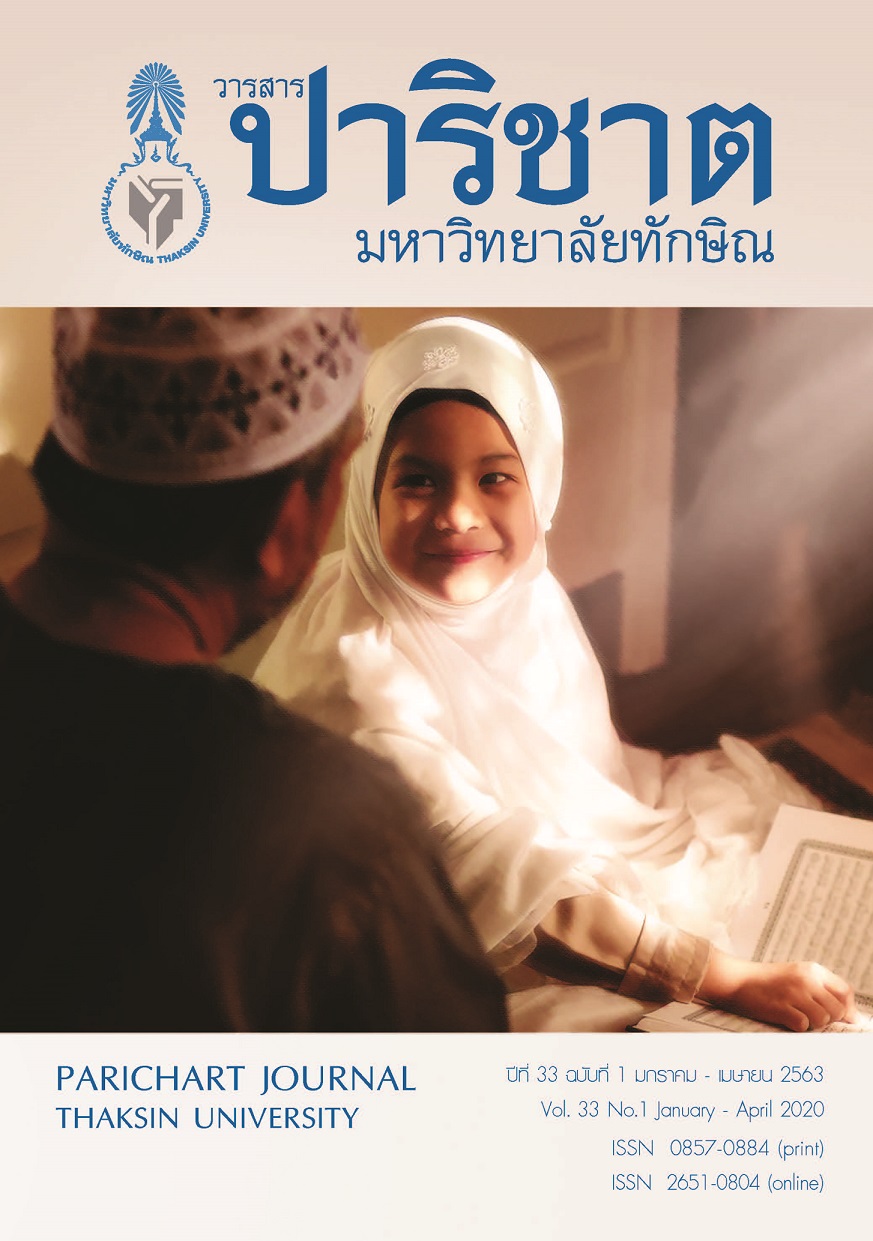นวัตกรรมการสืบทอดประเพณีแห่ผ้าขึ้นธาตุนครศรีธรรมราช
Main Article Content
บทคัดย่อ
นวัตกรรมการสืบทอดประเพณีแห่ผ้าขึ้นธาตุนครศรีธรรมราช มีวัตถุประสงค์ เพื่อศึกษาประวัติ รูปแบบ
กระบวนการ และคุณค่าของประเพณีแห่ผ้าขึ้นธาตุนครศรีธรรมราช เพื่อศึกษาเชิงวิเคราะห์รูปแบบและกระบวนการของประเพณีแห่ผ้าขึ้นธาตุนครศรีธรรมราชที่เหมาะสมกับบริบทสังคมปัจจุบัน และเพื่อศึกษาแนวทางการอนุรักษ์สืบทอดประเพณีแห่ผ้าขึ้นธาตุนครศรีธรรมราช เก็บข้อมูลโดยการวิจัยเอกสารและสัมภาษณ์เชิงลึก ผลการวิจัยพบว่า ในอดีตมีชาวเมืองอินทปัตย์หรือหงสาวดี ได้เดินทางไปนมัสการบรมธาตุที่ลังกา เกิดพายุพัดเรือแตกมีผู้รอดชีวิตมาขึ้นฝั่งอำเภอปากพนัง พร้อมกับผ้าขาวผืนยาวมีภาพพุทธประวัติเรียกว่า “ผ้าพระบฎ” ชาวปากพนังนำมาถวายพระเจ้าศรีธรรมโศกราช พระองค์โปรดให้นำผ้าพระบฎขึ้นห่มองค์พระบรมธาตุเจดีย์ แต่เดิมได้กระทำในวันขึ้น 15 ค่ำ เดือน 6 ต่อมาในรัชกาลที่ 4 ได้กระทำกันในวันขึ้น 15 ค่ำ เดือน 3 วันมาฆบูชา ประชาชนจะทำบุญและแห่ผ้าเวียนรอบพระบรมธาตุเจดีย์ 3 รอบก่อนนำห่มองค์พระบรมธาตุเจดีย์ รูปแบบประเพณีแห่ผ้าขึ้นธาตุ เพื่อความเหมาะสมกับบริบทสังคมปัจจุบันมีกระบวนการเตรียมบุคคล สถานที่การสมโภชผ้าพระบฎ ขบวนแห่ถวายผ้าพระบฎก่อนนำขึ้นห่มองค์พระบรมธาตุเจดีย์คุณค่าจากประเพณี คือ ความเลื่อมใสศรัทธาต่อพระพุทธศาสนา ช่วยฟื้นฟูความสัมพันธ์ในครอบครัว ความเสียสละ ความสามัคคีและส่งเสริมเศรษฐกิจการท่องเที่ยว ภายหลังได้รับพระราชทานผ้าพระบฎจากสมเด็จพระเทพรัตนราชสุดาฯ สยามบรมราชกุมารี แนวทางอนุรักษ์สืบทอดประเพณี หน่วยงานภาครัฐและเอกชนต้องร่วมมือกันสร้างสรรค์ประเพณีแห่ผ้าขึ้นธาตุที่มีคุณค่าด้วยการให้เยาวชนได้ศึกษาเรียนรู้และการสร้าง
จิตสำนึก โดยผ่านประเพณีแห่ผ้าขึ้นธาตุเพื่อการอนุรักษ์และสืบทอดประเพณีต่อไป
Article Details
เอกสารอ้างอิง
Na Nakorn, P. (1978). Khamnam Nai Nakornsithamrat. Rongphimaksornsamphan. (In Thai)
Maneechote, P. (1978). Phraphutsatsananaipaktai (chiwitthaipaktai). Witcha Journal:(Special issue) 4(3-4) March – May 1978 and June – August 1979. 3. (In Thai)
Wisalo, P. (2003). Phutsatsanathainai anakhot Næonomlæthang Okchakwikrit. Bangkok: Samnakpim munnithisot-s-isalittwong. (In Thai)
Atwiphakphaisan, A. (1991). Namchomnakornsithamrat. Bangkok: Rongphimls. (In Thai)
Nunsuk, P. & Teeraku, L. (1996). Phraborommathatchedinakorniithamratkapsinlapawatthanatham Læsangkhom. Nakornsithamrat Raingankansammanaprawatsatnakornsithamrat. 4thed. Sinlapawatthanathamkapkanplianplængthangsetthakitlæsangkhomkhongnakornsithamrat, Rungsinkanphi. (In Thai)
Suppharakan, C. (1980). Chiwitt haipaktai Chutthi 4. Nakornsithamrat. Suwatthanatham Phaktai Witthayalaikhrunakornsithamrat. (In Thai)
Nunsuk, P. (1980). Rattanathatmunianusorn.Thiralrknainganphraratchathanphloengsopphrarattanathat muni. (bænkhonPhonnoParian) Watphramahathatworamahawihan.Changwatnakornsithamrat. Bangkok: Krungsiamkanphim. (In Thai)
Na Nakorn, W. (1978). Nanmưangnakornsithamrat Lænanphrathatmuangnakornsithamrat: Nakorn si thamrat. Rongphim aksornsamphan. (In Thai)


